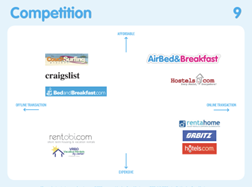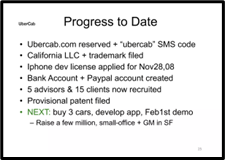A strong pitch deck is a must for any academic entrepreneur aiming to take their research to the next step and launch a start-up. Decks are the foundation of how ideas are communicated in business but translating years of rigorous research and ambitious plans into a concise and digestible presentation requires strategy, clarity, and a deep understanding of your audience in the market. So, how can you create a pitch deck that captures attention and inspires confidence in your start-up?
1. Start with your Elevator Pitch
The opening slide of your deck sets the tone for the rest of your presentation. To quickly capture the attention of potential investors, as well as succinctly explain who you are as a company, a strong introduction should be a one-sentence summary of your company’s purpose: often referred to as an “elevator pitch.”


Introductory slides from the actual pitch decks of Uber (left) and AirBnB (right); notice how both include their short “elevator pitch” on this first slide.
2. State the problem and present your solution
What’s the real-world problem your start-up can solve, and how? The answer should be front and center in your pitch deck. Investors want to see that you’ve identified a meaningful and real issue and that your solution is an innovative and viable approach to closing the current gap in the market. All startups hinge on this problem-solution dichotomy and framing it through storytelling – making your investors feel the customer’s problem and see how your solution stands out from existing options – is one way you can go on to make your deck more relatable and memorable.


AirBnB’s example is a good baseline for presenting your problem-solution to investors. Note how their problems were very customer-centric; people are sensitive to price and seek authentic experiences, but there is no current market solution that addresses both.
3. Define the market and opportunity
As a researcher, it may not always be easy to translate the work you’ve done in the lab into commercial potential. Nonetheless, investors will be extremely keen to see that your solution addresses a substantial and growing market – often quantified in a metric like the total addressable market (TAM). Data-driven market insights into market opportunity will significantly bolster investor confidence in the business success of what you want to bring to market.


Here, AirBnB shows the userbase of competitor services (left) as well as the TAM and other market sizing metrics.
4. Emphasize what separates you from competitors
As academic entrepreneurs, your competitive edge often lies in the groundbreaking proprietary research or intellectual property you have produced – something that is highly attractive to investors. So, make sure your deck simply and explicitly demonstrates how your research is superior to what’s already on the market. If there is truly nothing similar that currently exists, make that known as well. Acknowledging who your competitors are and clearly articulating what unique strengths your startup brings gives investors’ confidence that you are aware of the broader market and have a strategic vision.


On the left is how Uber enumerated its key differentiating features. On the right, AirBnB presented a competitor analysis and showed how they fit into what is known as a “white space.”
5. Provide a roadmap and key milestones
Turning academic research into a ready-for-market product can span years. Outlining clear timelines and strategic milestones to potential investors is especially critical, as investors have to be sure that you have already made significant research progress and have a defined plan for moving forward. Take this as an opportunity to brag, highlighting all of the work you have done thus far. And make sure to have actionable next steps, setting out clearly what your startup needs to do to successfully grow and expand.

Uber’s titled their slide “Progress to Date,” detailing what they had already did and including clear, actionable next steps as well.
While these tips are far from exhaustive, following these strategies will put you on the path to creating a pitch deck that not only resonates with but excites investors about the innovations you’re hoping to commercialize. Distilling years of research into a brief, compelling deck is no small feat, so focus on continuously refining your “elevator pitch,” emphasizing what value you bring to the market, and, above all, letting your passion for your research shine through!
– Parker Wenig